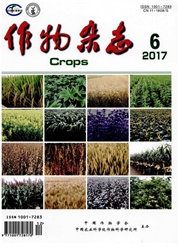

 中文摘要:
中文摘要:
Soybean cyst nematode(SCN) is one of the most devastating pathogen for soybean. Therefore, identification of resistant germplasm resources and resistant genes is needed to improve SCN resistance for soybean. Soybean varieties Huipizhiheidou and Wuzhaiheidou were distributed in China and exhibited broad spectrums of resistance to various SCN races. In this study, these two resistant varieties, combined with standard susceptible varieties(Lee and Essex), were utilized to identify the differentially expressed t ranscripts after infection with SCN race 4 between resistant and susceptible reactions by using the Affymetrix Soybean Genome Gene Chip. Comparative analyses indicated that 21 common genes changed significantly in the resistant group, of which 16 increased and 5 decreased. However, 12 common genes changed significantly in the susceptible group, of which 9 increased and 3 decreased. Additionally, 27 genes were found in common between resistant and susceptible reactions. The 21 significantly changed genes in resistant reaction were associated with disease and defense, cell structure, transcription, metabolism, and signal transduction. The fold induction of 4 from the 21 genes was confirmed by quantitative RT-PCR(q RTPCR) analysis. Moreover, the gene ontology(GO) enrichment analyses demonstrated the serine family amino acid metabolic process and arginine metabolic process may play important roles in SCN resistance. This study provided a new insight on the genetic basis of soybean resistance to SCN race 4, and the identified resistant or resistant-related genes are potentially useful for SCN-resistance breeding in soybean.
 英文摘要:
英文摘要:
Soybean cyst nematode (SCN) is one of the most devastating pathogen for soybean. Therefore, identiifcation of resistant germplasm resources and resistant genes is needed to improve SCN resistance for soybean. Soybean varieties Huipizhiheidou and Wuzhaiheidou were distributed in China and exhibited broad spectrums of resistance to various SCN races. In this study, these two resistant varieties, combined with standard susceptible varieties (Lee and Essex), were utilized to identify the differentially expressed transcripts after infection with SCN race 4 between resistant and susceptible reactions by using the Affymetrix Soybean Genome GeneChip. Comparative analyses indicated that 21 common genes changed signiifcantly in the resistant group, of which 16 increased and 5 decreased. However, 12 common genes changed signiifcantly in the susceptible group, of which 9 increased and 3 decreased. Additionally, 27 genes were found in common between resistant and susceptible reactions. The 21 signiifcantly changed genes in resistant reaction were associated with disease and defense, cell structure, transcription, metabolism, and signal transduction. The fold induction of 4 from the 21 genes was conifrmed by quantitative RT-PCR (qRT-PCR) analysis. Moreover, the gene ontology (GO) enrichment analyses demonstrated the serine family amino acid metabolic process and arginine metabolic process may play important roles in SCN resistance. This study provided a new insight on the genetic basis of soybean resistance to SCN race 4, and the identiifed resistant or resistant-related genes are potentially useful for SCN-resistance breeding in soybean.
 同期刊论文项目
同期刊论文项目
 同项目期刊论文
同项目期刊论文
 Construction of a high-density genetic map based on large-scale markers developed by specific length
Construction of a high-density genetic map based on large-scale markers developed by specific length Isoflavone Content of Soybean Cultivars from Maturity Group 0 to VI Grown in Northern and Southern C
Isoflavone Content of Soybean Cultivars from Maturity Group 0 to VI Grown in Northern and Southern C 期刊信息
期刊信息
